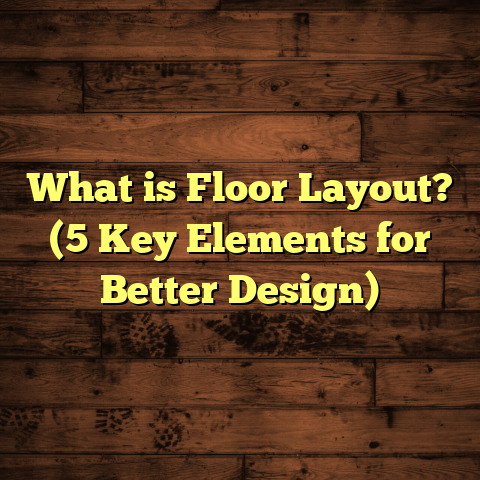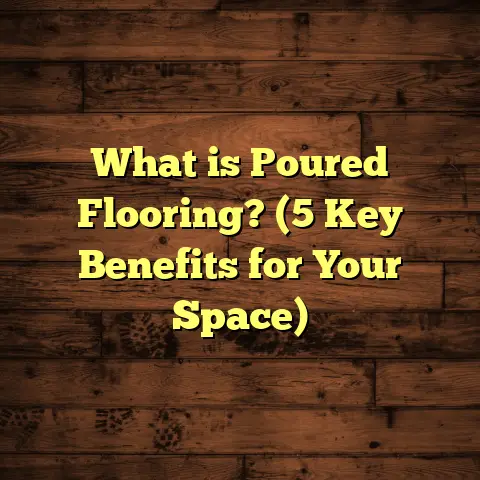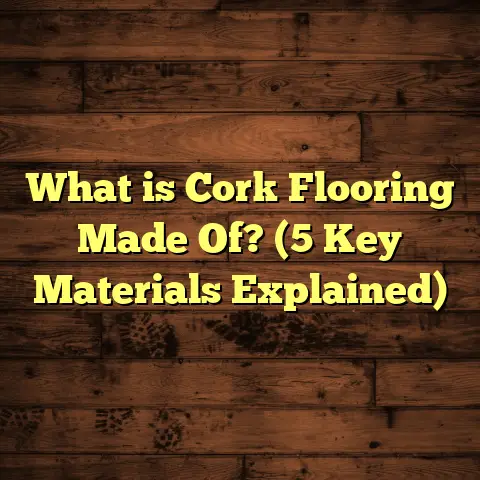What is Floating LVP Flooring? (5 Benefits You Need to Know)
Customizing a home is one of the most rewarding parts of owning or renovating it. When I think about flooring, what excites me the most is the incredible variety and flexibility you get with options like floating LVP flooring. It’s a game-changer if you want a stylish, durable floor without the hassle of traditional installation methods.
What is Floating LVP Flooring?
So, what is floating LVP flooring exactly? LVP stands for Luxury Vinyl Plank, which is a type of vinyl flooring designed to mimic the look of real wood planks. The “floating” part means the planks don’t get glued or nailed down to the subfloor. Instead, they lock together and rest on top of an underlayment or existing floor. This makes installation faster, cleaner, and often doable by homeowners themselves.
Floating LVP flooring combines the aesthetic appeal of hardwood with the practical benefits of vinyl. It’s waterproof, scratch-resistant, and softer underfoot than ceramic tile or stone. The locking system creates a stable surface that can expand and contract with temperature changes without damaging the floor.
When I first started using floating LVP floors in my projects, I was amazed at how quickly I could transform a space. What used to take days with hardwood or tile could be done in a few hours. Plus, if you ever want to change your style, you can remove it without tearing up the subfloor.
How Does It Work?
The planks have a click-lock mechanism on their edges. You simply snap them together like puzzle pieces over a foam or cork underlayment. The underlayment helps with sound reduction and adds a bit of cushion. Since the flooring isn’t fixed to the subfloor, it’s called “floating.”
This method also means you can install LVP over many types of existing floors—vinyl, tile, concrete, even some carpets—without ripping everything out. That saves time, money, and a lot of mess.
Materials and Construction
Luxury Vinyl Plank usually has several layers:
- Wear Layer: The top protective coating that resists scratches and stains.
- Design Layer: A high-resolution image layer that replicates wood grain or other patterns.
- Core Layer: Often made from PVC or WPC (wood plastic composite), this provides stability and waterproofing.
- Backing Layer: Adds support and moisture resistance.
The thickness varies, typically between 4mm and 8mm. Thicker planks feel more solid and absorb sound better.
Five Benefits You Need to Know About Floating LVP Flooring
I’ve worked with various flooring materials over the years but floating LVP has some standout perks that always make me recommend it. Here are five big benefits I think you should know:
1. Easy Installation Saves Time and Money
Because floating LVP doesn’t need glue, nails, or special adhesives, installation is straightforward. I’ve installed these floors in my own home, and even with zero prior experience, I managed to do it over a weekend.
For professional projects, the speed translates into less labor cost. According to recent industry data, installing floating LVP can be up to 30-50% faster than traditional hardwood flooring installation. That means fewer hours on site and quicker job completion.
Also, since you can install it over most existing floors, prep work is minimal. That reduces demolition costs and dust.
Have you ever dealt with ripping up old tile? It’s a nightmare! Floating LVP lets you skip that headache in many cases.
Here’s a little extra: I remember a job where we installed floating LVP over an old linoleum floor that was still in decent shape. Instead of tearing it out and dealing with disposal fees and dust everywhere, we just laid underlayment on top and locked the planks down. The client was thrilled because it saved her almost $1,000 in labor and disposal costs alone.
2. High Durability and Water Resistance
One thing that blew me away was how tough these floors are. The wear layers on quality LVP products are made to resist scratches from pets, furniture, and everyday foot traffic.
Plus, because vinyl itself is waterproof, floating LVP floors handle moisture far better than hardwood or laminate. This makes them perfect for kitchens, bathrooms, basements—anywhere moisture is a concern.
In fact, my own basement remodel used floating LVP because of its water resistance. After heavy rains, I never worried about water damage like I would with wood.
A report from a flooring durability study showed that premium LVP floors last 15-20 years with proper care in residential settings—comparable to hardwood but with less maintenance hassle.
Beyond just water resistance, some brands offer enhanced antimicrobial properties embedded in their wear layers to help reduce mold growth—something I didn’t expect but found useful especially for basement installations.
3. Customizable Looks for Every Style
If you like mixing aesthetics or want a specific vibe in each room, floating LVP flooring offers nearly limitless design options.
You can find planks that mimic oak, walnut, hickory—even exotic species like Brazilian cherry—without the cost or environmental impact of real wood.
Some brands even offer textured surfaces that feel like real wood grain or painted finishes for a rustic farmhouse look.
One client once asked me for a vintage gray wood effect that matched her kitchen cabinets perfectly. We found an LVP collection that nailed the color and texture; she was thrilled with how it pulled the whole room together.
With floating LVP, you’re not locked into one look—you can mix and match styles between rooms or change your mind later by swapping out planks.
If you’re curious about trends: right now wider planks (7 inches or more) with matte finishes are very popular because they create an airy, contemporary feel while still mimicking natural wood beautifully.
4. Comfortable and Quiet Underfoot
If you’ve ever walked on tile or laminate floors all day, you know how tiring it can be on your feet and joints. Floating LVP floors tend to be softer because of their layered construction and foam underlayment beneath.
This cushioning effect makes standing for longer periods easier—something I appreciate when working in kitchens or playrooms.
Also, the sound absorption reduces echoes and footsteps noise dramatically compared to harder surfaces like tile or hardwood installed directly on concrete.
I remember installing floating LVP in an apartment complex where noise complaints were common before. Afterward, residents reported much quieter hallways and interiors.
Data from acoustic testing labs shows that floating LVP installed over quality underlayment can reduce impact sound transmission by up to 20 decibels compared to hard floors without underlayment.
5. Great Value for Your Money
Quality flooring doesn’t have to break the bank. Floating LVP offers excellent value because it balances cost, durability, appearance, and ease of installation.
To give you some numbers: Hardwood flooring prices usually range from $8 to $14 per square foot installed. Laminate tends to be $3 to $8 per square foot installed. Floating LVP often fits comfortably between $4 and $9 per square foot installed depending on brand and features.
In my experience managing budgets for several home renovations, choosing floating LVP helped stretch funds without compromising style or performance.
I also rely on tools like FloorTally when estimating these costs for clients or my own projects. It pulls local labor and material rates into easy-to-understand breakdowns so I can see exactly where money goes. It’s handy because it factors in waste percentages too—something I always forget until last minute!
Using FloorTally has saved me hours by consolidating quotes from multiple suppliers and contractors into one dashboard—cutting out guesswork and preventing costly surprises during installation phases.
My Personal Experience with Floating LVP Flooring
Let me share a little story that captures why I’m such a fan of floating LVP.
A couple of years ago, I helped my sister redo her living room floor before she moved into her first house. She wanted something that looked like wood but was kid-proof since she had two toddlers running around.
We decided on floating LVP because it was waterproof and hard-wearing but still warm-looking.
What surprised me was how fast we finished the entire floor in just one weekend without any professional help. The locking system was intuitive—even for someone slightly clumsy like me!
Since then, she’s had no issues with scratches or stains—even after spills and heavy play sessions—with minimal cleaning effort.
That experience confirmed for me that this type of flooring isn’t just practical; it’s genuinely suited for real family life.
Another time during a commercial job for a small café owner who wanted beautiful floors but couldn’t afford lengthy shutdowns or messy installs, floating LVP was perfect. We completed installation overnight without disrupting business hours—a huge win for everyone involved.
Installation Tips From My Toolbox
If you’re thinking about trying floating LVP yourself or supervising installers, here are some pointers I’ve picked up over time:
- Acclimate the Planks: Leave your planks in the room for 48 hours before installation so they adjust to temperature and humidity.
- Use Proper Underlayment: Choose foam or cork underlayment designed for vinyl floors to reduce noise and add comfort.
- Leave Expansion Gaps: Floating floors need space around edges (usually 1/4 inch) to expand and contract without buckling.
- Plan Your Layout: Start from the longest straight wall and stagger seams for a natural look.
- Check Subfloor: Make sure it’s clean, dry, level, and free of debris before starting.
- Cutting Planks: Use a utility knife or vinyl cutter rather than saws to reduce dust.
- Use Spacers: Place spacers along edges during installation to maintain consistent expansion gaps.
- Keep Temperature Stable: Try to install when room temperature is moderate (between 60-80°F).
I always recommend watching a few tutorial videos if you’re new—it really helps visualize how planks lock together.
What About Maintenance?
One of the reasons floating LVP is so popular is how simple it is to maintain:
- Sweep or vacuum regularly to remove dirt.
- Mop with a damp (not wet) microfiber mop using vinyl-safe cleaners.
- Avoid harsh chemicals or abrasive scrubbing pads.
- Use felt pads under furniture legs to prevent scratches.
- Quickly clean spills to avoid stains or odors.
- Periodically check seams for any lifting or damage.
Compared to hardwood floors that need refinishing every few years or tiles that grout gets dirty easily, floating LVP stays looking fresh with minimal effort.
An interesting fact: some newer wear layers include UV protection which resists fading from sunlight exposure—a big plus if your space has large windows.
Environmental Impact & Sustainability
You might wonder how floating LVP stacks up environmentally compared to traditional hardwood or laminate floors.
LVP is made primarily from vinyl (PVC), which is less eco-friendly than natural wood due to its petrochemical origins. However:
- Many manufacturers now recycle vinyl offcuts during production.
- Some brands offer products certified by FloorScore® for indoor air quality.
- The long lifespan reduces waste from frequent replacements.
- Because installation requires no adhesives or nails, there are fewer harmful VOCs released during fitting.
While hardwood is renewable if sourced responsibly, it often requires more maintenance chemicals over time (like finishes). Meanwhile, laminate floors may contain formaldehyde emissions initially.
So if sustainability is your priority but you still want durability and moisture resistance, look for LVP lines with environmental certifications like FloorScore® or GREENGUARD® Gold.
How Floating LVP Compares to Other Flooring Types
I want to break down some comparisons based on my years working across different flooring materials:
| Flooring Type | Cost per sq ft (installed) | Water Resistance | Durability | Installation Complexity | Maintenance |
|---|---|---|---|---|---|
| Floating LVP | $4 – $9 | Excellent | High | Easy | Low |
| Hardwood (solid) | $8 – $14 | Poor | High (with care) | Moderate to Difficult | Medium (refinishing) |
| Laminate | $3 – $8 | Moderate | Moderate | Moderate | Medium |
| Ceramic Tile | $5 – $15 | Excellent | Very High | Difficult | Medium (grout care) |
| Carpet | $3 – $7 | Poor | Low | Moderate | High (cleaning) |
This table shows why many homeowners lean toward floating LVP when balancing budget with performance—especially in moisture-prone areas where hardwood isn’t practical.
Real Case Study: Renovating a Kitchen with Floating LVP
I want to share a recent project that highlights floating LVP’s strengths:
The client had an outdated kitchen with worn-out linoleum flooring that stained easily. They wanted something modern-looking but budget-friendly since they were also redoing cabinets and countertops.
After evaluating options:
- We chose a textured oak-look floating LVP plank.
- Installation took two days with a small crew.
- We installed over existing linoleum after leveling the subfloor slightly.
- The client was amazed at how realistic the wood grain looked.
- Post-installation feedback: no water damage after weeks of cooking spills; cleanup was effortless.
The total cost came in 25% less than if we’d replaced with engineered hardwood including demolition fees.
This project reinforced my belief that floating LVP is an excellent solution for kitchen renovations where moisture resistance meets style needs without breaking budgets.
Frequently Asked Questions About Floating LVP Flooring
Q: Can floating LVP be installed on stairs?
A: It’s generally not recommended because stairs require secure adhesion for safety reasons. However, vinyl stair treads specifically designed for stairs exist as alternatives.
Q: How thick should my floating LVP be?
A: Most homeowners opt for 5mm to 7mm thickness for better durability and comfort; thicker planks also help mask minor subfloor imperfections.
Q: Is floating LVP suitable for radiant heat systems?
A: Yes! Many brands are compatible with radiant floor heating but check manufacturer specs before installation.
Q: Can I install floating LVP outdoors?
A: No. Vinyl planks are not designed for outdoor exposure; UV rays and weather cause damage over time.
Q: How do I repair damaged planks?
A: One advantage is easy repair—you simply unlock damaged planks and replace them individually without affecting surrounding pieces.
Final Thoughts: Is Floating LVP Flooring Right for You?
Thinking about all this, do you see why I recommend floating LVP so often? It’s flexible enough to fit many lifestyles—from busy families needing durability to design lovers wanting style variety without overspending.
If you want a floor that’s practical yet attractive, easy to install but built to last—and customizable enough to suit your personal taste—floating LVP should definitely be on your shortlist.
And if budgeting has you worried, tools like FloorTally can help you plan costs realistically so surprises don’t sneak up on you mid-project.
So what do you think? Would floating LVP flooring fit your home? If you want advice on brands or installation help, just ask—I’m happy to share more tips or stories!
If you want me to break down specific brand recommendations, installation guides step-by-step, or even tips on pairing floating LVP flooring with certain decor styles next time—just let me know!
I hope this helps you feel confident about whether floating Luxury Vinyl Plank flooring could be your next home upgrade!





